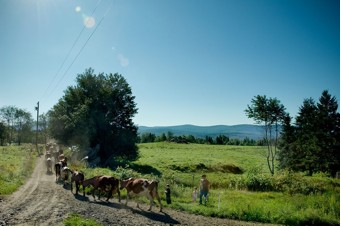Food shopping suggestions: Before you go shopping, make a list! Remember to shop the edges and try to buy as much bulk/whole food as possible. Whenever possible, buy in bulk from local vendors. You can place a special order through your Coop, go to the farmers market (Saturdays in Montpelier on State Street), or visit the vendors.
For local food sources, visit vermontfresh.net to search an extensive listing. Here are some to get you started:
Butterworks Farm – butterworksfarm.com – spelt, oats, rye, cornmeal, dry beans, yogurt, sunflower oil
Applecheek Farm – applecheekfarm.com – chicken, lamb, veal, pot pies, sausage
Cate Farm – catefarm.com – seasonal organic produce
Food selection criteria (Colbin, AnneMarie. Food and Healing. Random House, 1986.):
Keep it whole. Try to eat food as nature provided it, with all its edible parts intact. The body is smart: if there are nutrients missing from the food we eat, it is likely we’ll crave what’s missing and try to get it from other sources.
Choose fresh, real food. Avoid canned or frozen foods whenever possible; read labels and try to choose foods free from artificial sweeteners, antibiotics or hormones. If you can’t pronounce a word in the ingredients list, don’t eat it!
Cook with seasonal, local, non-genetically modified meat, dairy, grains and produce. Whenever possible we source ingredients direct from farmers using CSAs (community supported agriculture), and markets.
Prepare foods that are in harmony with tradition. Gain inspiration from the cuisines of different parts of the world and recognize that food many times can spark a memory of one’s history.
Find balance. Cook colorful foods that offer enticing flavor and texture; savor your meals! Sit down, breathe, and appreciate the nourishment that you need to live.
Dandelion Leek Frittata
You will need:
4 Tablespoons olive oil
1 large leek
2 teaspoons each: salt and black pepper
1 bunch fresh dandelion greens
6 eggs
1 teaspoon each: cumin and coriander powder
Juice of half a lemon
Chop 1 large leek into rounds.
Heat olive oil in a skillet and add leeks.
Reduce heat to medium low. Add salt, black pepper, cover, and simmer for 5 minutes.
Add dandelion greens. Simmer for 10 more minutes or until most of the liquid has cooked out of the vegetables.
Meanwhile, preheat oven to 375 degrees.
Grease a pie plate with olive oil.
In a bowl, beat 6 eggs, cumin, coriander, and a splash (about 4 Tablespoons each) of water and lemon juice.
Pour egg mixture over the top of the greens and bake for 40 minutes.
Healing Properties
Eggs: each one contains 6 grams of protein, 9 essential amino acids, and only 1.5 grams of saturated fat; rich in lutein, which helps prevent macular degeneration and cataracts; improve human lipid profile, thereby balancing cholesterol; contain naturally occurring vitamin D.
Dandelion greens: these iron-rich, fiber-filled spring greens stimulate the bitter flavor on the palate, which encourages bile production, thereby strengthening digestion and aiding liver rejuvenation.
Leeks: strengthen lungs; anti-microbial; anti-bacterial; offer rich source of fructo-oligosaccharides, which stimulate growth of healthy bifidobacteria and suppress the growth of potentially harmful bacteria in the colon.
Oaty Corn Bread
This is a great thing to bake with leftover oatmeal!
Preheat the oven to 375 degrees.
In a bowl, mix together:
1 cup corn meal (I like ‘early riser’ cornmeal from Butterworks farm)
1 cup leftover oatmeal (you can order 5 pound bags of local oats from Butterworks farm)
1 teaspoon each: salt, baking soda, baking powder, coriander and cumin
¼ cup vegetable oil (I like sunflower oil from Rainville farm)
Grease any 8 inch pan with vegetable oil.
Pour batter into greased pan.
Bake for 40 minutes, or until a knife inserted into the center tests clean.
Healing Properties
Oats: high in fiber to lower cholesterol levels and reduce risk of heart disease; ease digestive stress and support healthy transit time; enhance immune response to infection and stabilize blood sugar.
Savory Sweet Potato Bread
Dry ingredients:
1½ cups rice flour
1 teaspoon baking powder
1 teaspoon baking soda
½ teaspoon salt
Wet ingredients:
1 egg
2 Tablespoons lemon juice
Grated zest of 1 lemon
¼ cup vegetable oil
1 ½ cups steamed, mashed sweet potatoes
2 Tablespoons unsweetened, whole milk yogurt
Preheat the oven to 375 degrees.
Grease 8 or 9 inch pan with vegetable oil.
Combine the dry ingredients in a mixing bowl and stir together.
Make a well in the center, combine the wet ingredients and stir until thoroughly blended.
Incorporate wet and dry ingredients until they are well combined.
Pour batter into greased pan and bake for 50 minutes, or until a knife inserted into the center tests clean.
Healing Properties
Sweet potatoes: high in omega 3 essential fatty acids to tonify the internal organs and strengthen immunity; rich in carotenoids and omega-3s, whose anti-oxidant content offers anti-inflammatory support; high in vitamin C to boost immunity; rich in B vitamins to reduce stress.
Energy Bars
You will need:
¼ cup dried, unsweetened apricots
¼ cup dried, unsweetened dates
¼ cup raisins
¼ cup sesame seeds – toasted
¼ cup pumpkin seeds – toasted and coarsely chopped
½ cup walnuts, pecans, almonds (choose any combination of these) – toasted and coarsely chopped
1 cup nut butter (almond, cashew, peanut butter or a combination of these)
¼ cup honey
4 Tablespoons shredded, unsweetened coconut
1 teaspoon cinnamon
Pinch salt
Boil 2 cups water. As water boils, coarsely chop all dried fruit and place it in a small mixing bowl.
Pour boiling water over fruit. Soak for 15 minutes and drain.
Meanwhile, mix honey, nut butter, coconut, cinnamon and salt in a medium mixing bowl.
Chop walnuts/almonds and pumpkin seeds.
Toast all seeds and nuts. Add to mixing bowl and mix.
Add soaked dried fruit to the above ingredients.
Oil a glass baking dish: 7×11″ is a good size.
While the mixture is still warm, press it flat into the dish with wax paper. Chill for 1 hour.
Slice into squares.
Cover with plastic wrap or store in baking dish in the fridge. Keeps for 2 weeks refrigerated.
Healing Properties
Almonds: high in monounsaturated fat, which promotes heart health, helps reduce LDL cholesterol, and aids in carbohydrate metabolism, thus contributing to weight loss; contain flavoproteins to balance blood sugar and improve energy levels.
Sunflower seeds: contain selenium to detoxify liver and blood; contain magnesium to strengthen bones, calm nerves and support immunity.
Walnuts: rich in omega 3 essential fatty acids; gently laxative; cardio-protective; contain ellagic acid, which supports the immune system.
Zoom Balls
You will need:
1 cup tahini (roasted sesame seed butter)
½ cup cashew or almond butter
¼ cup honey (more or less to taste)
1 teaspoon each: cinnamon and cardamom powder
3 Tablespoons coarsely chopped walnuts
½ cup coarsely chopped almonds
2 oz unsweetened shredded coconut
Mix tahini, nut butter and honey until smooth.
Add coconut and nuts – mix in well. Mix in enough coconut to make dough thick.
Roll the dough into small balls. You can also spread the mixture onto a baking sheet and cut into squares.
Store the balls in baking tins in a cool place. They will last for 3 weeks.
Healing Properties
Coconut: plant-based alternative to saturated animal fats. It stimulates brain function and promotes intestinal motility; its anti-bacterial benefits make it an important fat to choose during times of illness or infection and is specifically indicated for combating intestinal parasites.
Tahini (roasted sesame seed butter): promotes elasticity of bones and joints; helps colon to extract water from food waste before elimination occurs.
Visit Lisa’s website at http://www.harmonizedcookery.com/
Source: Dig in VT Trails





